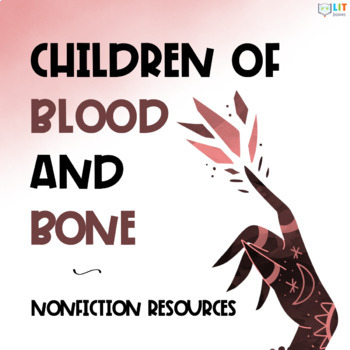Children of Blood and Bone: Nonfiction Readings & Activities Resources
- Zip
- Google Apps™

Also included in
- This product is a comprehensive set of instructional materials for teaching Children of Blood and Bone by Tomi Adeyemi. With over 140+ Common Core aligned materials, students will develop their literacy skills while deeply engaging with the novel. Plus, the literary analysis resources, critical consPrice $30.00Original Price $39.00Save $9.00
Description
The History of West Africa and the Yoruba culture are rich and complex. The author of Children and Blood and Bone weaves this history and culture throughout the fabric of the story. The materials in this resource will help your students thoughtfully engage and understand it as they develop critical skills aligned to the Common Core State Standards.
Digital Compatibility: This resource is also technology friendly! It can be utilized in classrooms where computers or tablets are central to instruction because the resource has been adapted for digital completion. The resource includes links for students to complete the student pages in Google Slides™. For instance, students can work with the documents in Google Drive™ or via Google Classroom. With these links, you can have students complete their work online. (NOTE: Not all assignments are conducive to digital completion; however the pages are still provided in the digital format.) All they will have to do is create a text box! There are links for every student work page, making the format friendly not only for technology but also trees.
Nonfiction Close Reading Lessons: The 10 close reading lessons develop students’ background knowledge about West Africa and Yoruba history and culture. Using these informational texts, students will learn about the complicated history of West Africa, Yoruba culture and its influence around the globe. Each close reading includes questions that will develop essential skills aligned to the reading of informational texts under the Common Core State Standards. After practicing these skills over the course of the unit, you can be confident your students will have mastered numerous skills, such as:
- Citing textual evidence to support analysis of the text.
- Summarizing the main idea of a text with supporting details.
- Determining the meaning of words or phrases as used in the text.
- Compare and contrast how multiple texts portray a subject.
Extension activities take your students deeper. You know your students best. Based on their interests, the extension activities provide an avenue for your students to enhance their investigation or demonstrate agency.
West African Ethnic Groups and Adinkra: Students will research the various ethnic groups found in West Africa. Then they will apply the Adinkra stamping technique to represent their newfound knowledge of these groups through complex symbols.
Empires and Timelines: The timeline activity tasks students with analyzing the history of West African empires. Students research various empires and create timelines of their history. Then, students create a large display of timelines to reflect and identify historical patterns.
The Slave Trade in Africa and Memorials: The memorial project will see students researching the memorials/monuments in West Africa memorializing the slave trade and the history of the slave trade in Africa. Students will draw upon their growing knowledge of African history to create their own memorial that recognizes and teaches about the realities of the slave trade.
Colonialism Across the Atlantic: For this activity, students will research colonialism in South America and the Caribbean. Then, students will create historical snapshots that capture that colonial history. Finally, students will participate in a gallery walk to learn about colonialism in the region.
Creation Myths: Students will study the Yoruba creation myth and compare it to the Vodoun creation myth. Then, students will represent the Yoruba creation myth through a comic.
Essay: Students will analyze the novel for its inclusion of history. Then, students will analyze the author’s choices for effectiveness.
Answer Key: The key provides potential answers for every question asked in every assignment if applicable. Of course, not all analytic questions have just one answer! Part of the strength of the analysis questions is the room they leave for students to demonstrate their unique thinking and use textual evidence to support their stance. Therefore, use the answers at your discretion but know they provide a solid foundation for the type of performance that makes for quality work.
The entire resource and its inclusive set of questions allow for multiple potential uses based on your determination about when and where it would be most helpful, either in-class or for homework. Regardless, every question is aligned to a relevant Common Core State Standard.
PLEASE NOTE: This resource is NOT EDITABLE! It is intended to be comprehensive, but if you have particular needs for your classroom, please contact me! (lauren@lit-lessons.com)






